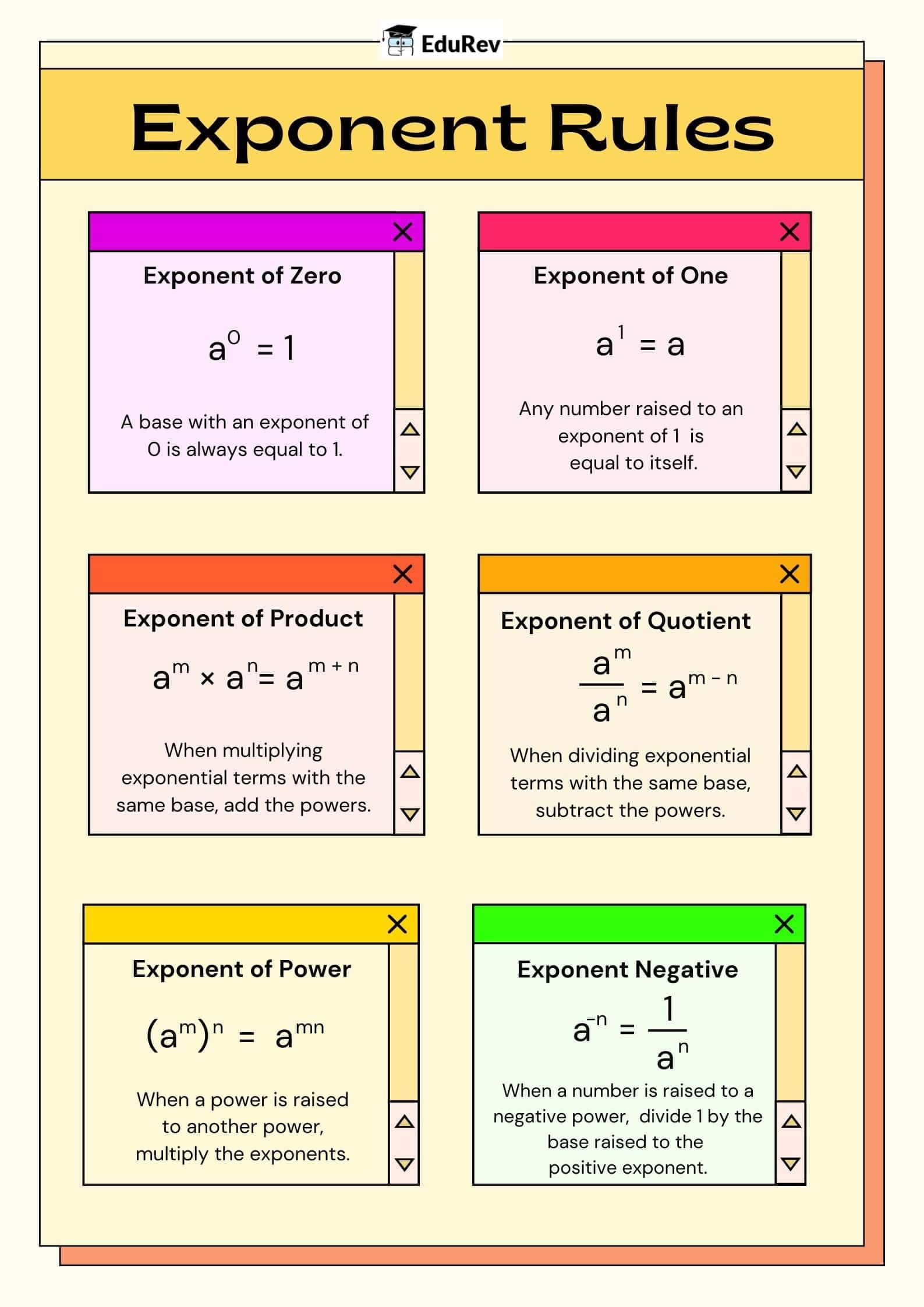Class 8 Exam > Class 8 Notes > Mathematics Class 8- New NCERT (Ganita Prakash) > Learning Poster: Exponent Rules
Learning Poster: Exponent Rules | Mathematics Class 8- New NCERT (Ganita Prakash) PDF Download

The document Learning Poster: Exponent Rules | Mathematics Class 8- New NCERT (Ganita Prakash) is a part of the Class 8 Course Mathematics Class 8- New NCERT (Ganita Prakash).
All you need of Class 8 at this link: Class 8
|
20 videos|149 docs|11 tests
|
FAQs on Learning Poster: Exponent Rules - Mathematics Class 8- New NCERT (Ganita Prakash)
| 1. What are the basic exponent rules I need to know for Class 8? |  |
Ans. The basic exponent rules include the following:
1. <b>Product of Powers</b>: When multiplying two powers with the same base, add the exponents: aᵐ × aⁿ = a^(m+n).
2. <b>Quotient of Powers</b>: When dividing two powers with the same base, subtract the exponents: aᵐ ÷ aⁿ = a^(m-n).
3. <b>Power of a Power</b>: When raising a power to another power, multiply the exponents: (aᵐ)ⁿ = a^(m×n).
4. <b>Power of a Product</b>: When taking a power of a product, distribute the exponent: (ab)ᵐ = aᵐ × bᵐ.
5. <b>Power of a Quotient</b>: When taking a power of a quotient, distribute the exponent: (a/b)ᵐ = aᵐ ÷ bᵐ.
| 2. How do I simplify expressions using exponent rules? |  |
Ans. To simplify expressions using exponent rules, first identify the bases and their exponents. Apply the relevant exponent rules step by step. For example, to simplify (x² × x³) ÷ x¹, you would first multiply the powers of x: x² × x³ = x^(2+3) = x⁵. Then divide by x¹: x⁵ ÷ x¹ = x^(5-1) = x⁴. Always look for opportunities to combine terms using the rules mentioned.
| 3. Can you explain how negative exponents work? |  |
Ans. Negative exponents indicate the reciprocal of the base raised to the opposite positive exponent. For example, a⁻ᵐ = 1/aᵐ. This means if you have an expression like 2⁻², it can be rewritten as 1/(2²) = 1/4. Understanding negative exponents helps in simplifying expressions and solving equations effectively.
| 4. What is the significance of zero as an exponent? |  |
Ans. Any non-zero number raised to the power of zero equals one. This rule is significant because it establishes a consistent value for expressions involving exponents. For example, 5⁰ = 1 and a⁰ = 1 for any a ≠ 0. This concept is vital in algebra and helps in simplifying complex expressions.
| 5. How can I apply exponent rules to solve equations? |  |
Ans. To solve equations involving exponents, first isolate the exponential term. Use the exponent rules to simplify or manipulate the equation. For instance, if you have an equation like 2^(x+1) = 8, you can express 8 as 2³, leading to 2^(x+1) = 2³. From here, you can equate the exponents: x + 1 = 3, and solve for x. This method helps in efficiently finding solutions to exponential equations.
Related Searches
















